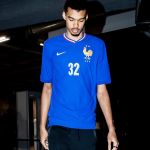
Nike and adidas are returning to the '90s font
Nostalgia is unstoppable, again
March 21st, 2024
Before the kits designed by Nike and adidas for the European Championship, Copa America, and future international competitions scheduled for the coming months were officially launched, as usual, leaks and spoilers provided us with a preview of their aesthetics. Even the French basketball player born in 2004, Victor Wembanyama, wore the new France home jersey in the pre-game fit of San Antonio Spurs against Brooklyn Nets, showing the three-dimensional font chosen by the Swoosh a few hours before the official drop. Both Nike and adidas have opted for a 3D typeface inspired by the aesthetics of the 1990s, yet not all national team jerseys will feature it on the back to display the players' names and numbers.
For example, as for adidas, the Spanish National Team jersey will be characterized by a 2D font, unlike Germany, which has opted for the 3D typeface. Probably, at least for the German company, this is a choice related to the kit identity: the design of the German kit, also thanks to a pattern that extends to the cuff of the long-sleeved version, nods to the one worn in 1992 and is therefore full of nostalgic vibes. The Albiceleste World Champions, instead, will continue with the 2D font. On the contrary, the design of the Spanish National Team jersey does not stem from inspiration from an archive kit; therefore, for aesthetic coherence, the numbers of the Selección adopt a more modern look.
They have currently adopted Nike's vintage typeface, the Polish, Portuguese, French, and Croatian national teams, unlike the Dutch and South Korean national teams, which have opted for a two-dimensional font. Once again, the concept of nostalgia, amidst a myriad of stylistic innovations launched by both brands, has managed to carve out an important space, both on the front and back of the jerseys. Serving as a complement to the vintage tone of the typeface, there are many other features. Starting from the Wales jersey that recalls the design used by the National Team in 1976 (produced by Hummel), passing through the central emblem on the Brazilian National Team kit, and the leaked rumors regarding Nike's re-issue operation. In fact, according to some rumors shared on The Shirt Union's X profile, the Swoosh will relaunch a Retro version of the jersey used at the 1998 World Cup by Ronaldo Nazario, spoiled by a shot featuring Vinicius Jr. More than ever, on the occasion of the recent launch, but also with future prospects in mind, adidas and Nike have created a perfect balance between innovation and nostalgia, between technology and aesthetics.
The result, beyond the controversies arising from the oversized dimensions of the crests of both suppliers, seems to be truly excellent. Just consider that in Nike's case, the three-dimensional typeface, the square collar of Nigeria's home jersey, will appear on the new, innovative Dri-FIT AD fabric. The National Team jerseys, thanks to a decidedly renewed aesthetic, gain a lot in terms of aesthetics due to the addition of the new numbers, yet this is not an absolute novelty for this type of font. Today, some clubs sponsored by PUMA, such as Borussia Dortmund, have three-dimensional numbers on the back; conversely, these are not positioned on the back of the jerseys of clubs playing in the Premier League, as the English top-flight league establishes a uniform typeface that only differs in shades (yellow, blue, red, black, and white). adidas and Nike's idea, with the introduction of the 3D typeface, could also be to increase jersey sales: with the growing interest from the public in purchasing vintage jerseys, incorporating 1990s numbers could prove to be a shrewd strategy. Very different, however, is the font chosen by Nike for the Norway kit, on which numbers and names will be printed in a very aggressive Viking font. As the Nordic national team did not qualify for Euro2024, Nike was able to experiment without breaking the collective graphic identity chosen for the competition.












